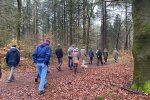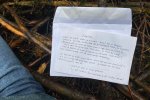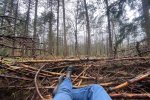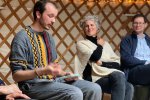Blog post
A more-than-human approach to forest management
A walk in the forest in silence. The participants hold hands and form a circle. They breathe for a moment with eyes closed. Then they turn around, still holding hands, and open their eyes. What, or in fact, who has your attention? Walk there, greet the beings you find there, and spend some time with them...
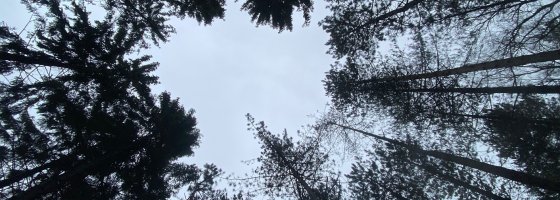
by Jelte Vredenbregt - photos by Bas Verschuuren
This might not immediately come across as an approach to forest management. However, MSc student Jan van Leeuwen found out that an approach like this can be of great value. On 22 February, he presented his internship project findings at Huis te Maarn Estate, which is part of National Park Utrechtse Heuvelrug in The Netherlands. Jan had the opportunity to explore and imagine a forest management plan in which humans and nature are treated as equals: ecocentrism. While human-nature relationships have become increasingly important in dealing with the biodiversity crisis, it is still a challenge how these insights are put into practice. Facilitating this quest, Boudewien van Notten, the 4th generation estate owner of Huis te Maarn, also inspires other estates to examine how human-nature relationships can be re-imagined, and subsequently be translated into decision-making for forest management.
Jan's research consisted of 15 in-depth walking interviews about forest management and relationality, inspired by the multiple evidence-based approach. Then he did an experiential ethnographic study of the forest with the aim of developing his connection to the place and the forest. For this study, Jan built a base camp to sleep in, and stayed day and night in the forest for a week. He conducted a ritual every night to express his gratitude to all wind directions, and to set the intention to be in touch with all living beings in the forest. In addition, he meditated every day for an hour in a different part of the forest. His experiences are portrayed in a reflective journal. In his report, alongside the insights from a group of interviewees, Jan uses his experiences to deepen the forest management plan in which the voices of non-humans are represented, while respecting current laws and regulations.
After his research project has ended, Jan and Boudewien organised an outing for those who were involved in the project. Rather than just presenting the results, Jan put his findings into practice by immersing the participants in nature experiences and a dialogue, with music and stories. You can follow the photos and story to get a taste for what that was like.
Jan tells about the dialogue: “The dialogue brought a lot of insights, mainly about landscape decision-making as well as personal decision-making processes from an ecocentric point of view. For example, we talked about a case in which trees would be cut down to make space for the “higher nature value” of a heather landscape. It was stated that if people living on the land are considered as part of the system, i.e. “the living whole of what the estate is”, then the decision for heathland can be a good one, as long as it fits the unicity of the people connected to it. Only then will life energy flow for the extensive maintenance of heathland, and humans can be seen as a keystone species in the landscape. Also, we concluded that one true representation of nature - and therefore one ‘right’ decision about the forest – does not exist; one can only base oneself on the lived experience and consciousness of the unseparable connection between one’s decisions and the whole of life."
FNP would like to thank Boudewien van Notten for providing the space for this internship project.
Find out more about Jan’s project on his blog (in Dutch): https://www.verbondenbos.nl/
